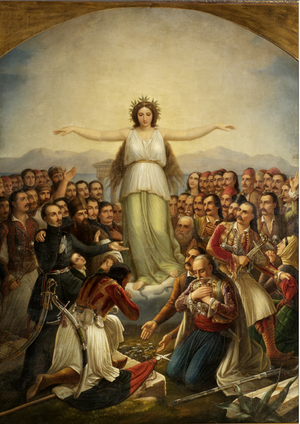| This article covers a war or battle
|
| The Battle of Ostambal | |||||||
|---|---|---|---|---|---|---|---|
| |||||||
| Belligerents | |||||||
| Commanders | |||||||
| Strength | |||||||
| 12.500 men | 6.000 men | ||||||
| Casualties and losses | |||||||
| 10.000 dead | Unknown, heavy | ||||||
The Battle of Ostambal marked the final battle between Parsian Empire and the Enosis Revolutionaries, the decisive victory of the joint Selloi-Sarbian revolutionaries over the Parsians in the gates of his capital, Ostambal, marked the end of The Enosis and the fall of the Parsian Empire in the peninsula.
Background[]
The united troops of the Enosis leaded by Daskalaris finally reunited all in front of Ostambal, capital of Parsian Empire and fight against the empire in the land, when the victory of the Sarbians in Navarena was noticed by the Ruthenes, Daskalaris leaded a offensive in the porte of Ostambal achieved after 3 weeks of siege the opening of the great gate of the city, After twenty years of war and the destruction of almost all the countryside, the Hellenes take Ostambal in April of 3215 by the entrance of Konstantinos Daskalaris and Manuel Notaras in a triunphal entry in the abolished Parsian Empire, after achieved the Parsian Muhammad Hady Faiz, the last governor and loyal to the sultan surrender and ejects completely from the country, with the victory of the revolutionaries and the definitively liberation of all Orthodox people of Ruthenia, victory of the revolutionaries was declared on 23 May 3216
Under the pressure of Daskalaris, the Porte finally agreed on the terms of the Great Treaty and accept the defeat of the Parsians. Soon afterward, the new Ruthenes and the Sarbians conceive the idea of create a new Ruthene state in the conquered peninsula and create a "own orthodox based empire in ancient land of the Selloi and the Serbians"
Consequences[]
The consequences of the Enosis were somewhat ambiguous in the immediate aftermath. the Ecumenical Patriarchate of Auronopolis called to a holy synod to elect a new leader of the Hellenes and the Sarbians called to joint and mayor influence of the politics of the new state, Daskalaris and other Meteriotes accepted and called for a new ruthene council.
Rapidly the conquerors established a Synod to elect a new Basileus, the most notable families of the revolutionary army, the Bragationi, the Philaras, Daskalaris and Altomanovic want a Ruthenian emperor, heir and protector of the new Ruthenes for this ideal not ever allow a foreign ruler, the Hellenes had to survive and govern themselves, for this the ecumenical patriarch Gennadios III elected as protector of the Ruthenes to Konstantinos Daskalaris, since then Konstantinos is named as Konstantinos I, Basileus (King of Kings in Hellenic) of the Ruthenians, Selloi and Mauryans, his name being acclaimed by all the Ruthenians in the renowned city of Auronopolis in 3216.
The consequences of the revolution bring the exile or domination of Parsian people and the stablishment of a Ruthenian Empire, the first Ruthene leader was Konstantinos Daskalaris himself, named Basileus by Orthodox tradition.
In the long-term historical perspective, this marked the collapse of the Parsian Empire, the parsian people was exiled to Mauria or across the sea, without a leader and his government abolished, the few survivors travelled to the north o get "hellenized" by the new Ruthene state. For the first time, a Christian subject people had achieved independence from the Parsian rule and established a fully independent state, recognized by all the continent. this caused the riots in Maurya ended in another war where the kingdom was annexed and marked the Ruthenian-Maurian War and all the ancient Kormenian territories in a new Ruthene state, the Ruthenes considered themselves as the protectors of the Orthodox people in the peninsula and was recognized by various nations around the world.
The enosis marked too the union of the Sarbian people of the Ruthene Empire and the peaceful cultural union of the both peoples, leaded by Tomislav Altomanovic and his allies in the battle of Navarena, notwithstanding that the creation of the new state also brought a Parsian heritage and nearly destroyed both Konstantinos and his son Theodoros devoted nearly 20 years in the reconstruction and various land reforms and modernization of the empire against new technologies in all the world.

